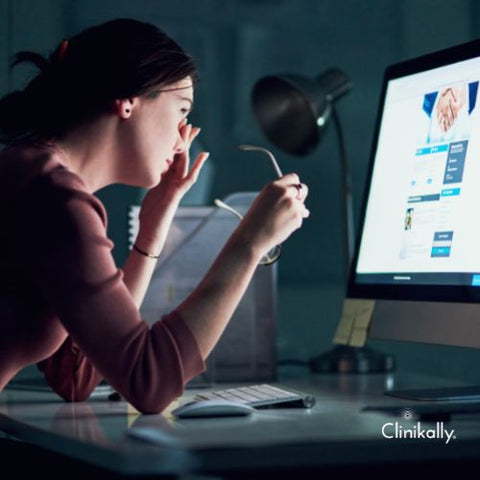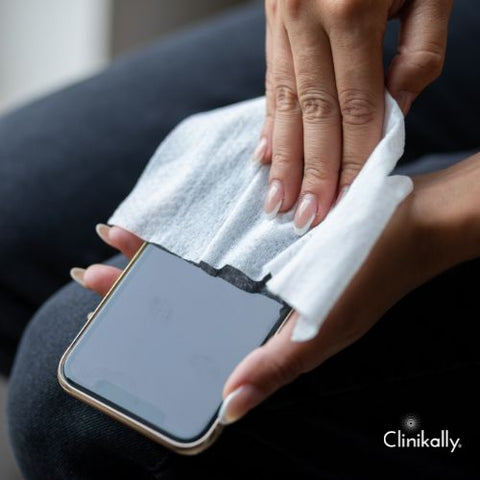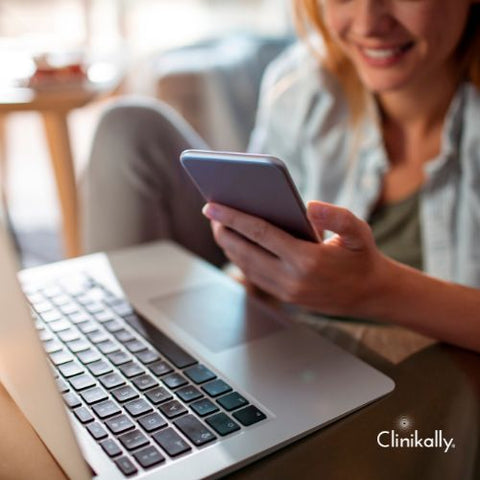Phone addiction is a growing problem that can have a negative impact on our health and well-being, including potential skin damage. In this blog, we'll look at the link between phone addiction and skin damage, as well as some prevention tips.
The Risks of Phone Addiction on Skin Health

Phone addiction can have several risks to skin health due to prolonged exposure to blue light and radiation emitted by the devices. Here are some of the potential risks:
-
The blue light emitted by phones can penetrate deep into the skin and cause damage to collagen and elastin, which are important proteins that keep our skin looking youthful and firm. This can lead to premature ageing, such as fine lines, wrinkles, and sagging skin.
-
Blue light exposure may increase the production of melanin, resulting in dark spots and uneven skin tone. This can be especially noticeable on the cheek and temple, which are parts of the face that are closest to the phone.
-
The radiation that cell phones emit can inflame the skin, resulting in redness, itchiness, and even acne. This is especially valid for people who frequently and continuously use their phones.
-
Phone addiction can also affect our sleep patterns, which can impact our skin health. Poor sleep can lead to dark circles, puffy eyes, and a dull complexion.
The Impact of Blue Light and UV Rays on Skin Damage: Wrinkles, Fine Lines, and Dark Spots
Blue light and UV rays can seriously harm the skin, causing wrinkles, fine lines, and dark spots. This is how:
-
Wrinkles: Both blue light and UV rays can harm the skin's collagen and elastin fibres, which are necessary for keeping the skin firm and smooth. This damage can cause wrinkles over time, especially in areas of the face that are exposed to the sun or blue light from electronic devices.
-
Fine Lines: Blue light exposure can also cause fine lines to form, particularly around the eyes and mouth. This is due to the fact that blue light can penetrate the skin deeper than UV rays, causing damage to the underlying collagen and elastin fibres.
-
Dark Spots: UV rays, also known as hyperpigmentation, are a common cause of dark spots. When the skin is exposed to UV rays, it stimulates the production of melanin, which is responsible for the colour of our skin. This can result in the formation of dark spots over time, particularly on sun-exposed areas of the face such as the cheeks, forehead, and nose.
It's crucial to take precautions to reduce exposure if you want to protect your skin from the harmful effects of UV and blue light. The following advice:
-
Every day, even on cloudy days, use broad-spectrum sunscreen with at least SPF 30. This will assist in shielding your skin from blue light and UV rays.
-
There are now blue light filters available for many electronic devices, including computers and smartphones, which can help limit exposure to blue light. Use these filters if possible, especially in the evening or right before bed.
-
Wear protective clothing, such as hats and long sleeve shirts, when you're outside to reduce your exposure to UV rays.
-
Take frequent breaks when using electronics to give your eyes and skin a break. Consider adhering to the 20-20-20 rule, which recommends pausing every 20 minutes to gaze at a distant object for 20 seconds.
By following these instructions, you can lessen the negative effects that UV and blue light have on your skin and delay the appearance of wrinkles, fine lines, and dark spots.
The Connection between Phone Addiction and Acne, Dermatitis, and Eczema
Acne, dermatitis, and eczema can all be related to phone addiction. This is how:
-
Acne: Our phones serve as a breeding ground for bacteria, which can then transfer to our skin when we use them. This can result in breakouts, especially on areas of the face that come into contact with the phone, such as the cheek and chin. Furthermore, the heat generated by the phone can cause sweating, which can aggravate acne.
-
Dermatitis: Some people may develop contact dermatitis as a result of their phones, especially if they are allergic to certain materials or chemicals found in phone cases. This can cause skin redness, itching, and irritation.
-
Eczema: Eczema is a chronic skin condition that can be triggered by stress. Phone addiction and constant use of electronic devices can lead to stress and anxiety, which can exacerbate eczema flare-ups.
Here are some suggestions to stop these skin conditions from arising or getting worse:
-
To reduce bacteria on your phone's surface, wipe it down with a disinfectant wipe on a regular basis.
-
When using your phone, try to avoid touching your face, especially if you haven't washed your hands.
-
To reduce phone-to-face contact, think about using a hands-free gadget like Bluetooth earpieces or headphones.
-
Choose a phone case made of silicone or rubber if you want to reduce the risk of skin irritation.
-
Give your skin a break from your phone on a regular basis to relieve stress and anxiety and to give your skin a rest.
The Risks of Cellulitis and Bacteria from Touchscreens
Bacteria that enter the skin through a cut, scrape, or other wound give rise to cellulitis, a bacterial skin infection. In rare instances, bacteria from touchscreens can cause cellulitis. Smartphone and tablet touch screens are particularly susceptible to the bacteria Staphylococcus aureus and Streptococcus pyogenes, both of which can lead to cellulitis. When we touch our devices, the bacteria on them may move from our hands to our skin, increasing the risk of infection. Cellulitis symptoms include redness, swelling, pain, and warmth in the affected area. If the infection is not treated, it can spread and cause more serious health problems.
Good hygiene must be followed in order to lower the risk of cellulitis and other bacterial infections from touchscreens. Here are some suggestions:
-
Wash Your Hands: Wash your hands frequently, especially before and after using a phone or tablet.
-
Clean Your Device: Use a disinfectant wipe or cloth to regularly clean your device.
-
Don't Share Your Device: To lessen the chance of bacteria spreading, don't let others use your phone or tablet.
-
Cover Cuts and Wounds: To lessen the chance of infection, keep any cuts or wounds on your skin covered with a bandage or dressing.
-
Seek Medical Attention: If you experience cellulitis symptoms, contact a doctor right away. Antibiotics can be used to treat cellulitis, but quick action is required to stop the infection from spreading.
You can lessen your risk of developing cellulitis and other bacterial infections from touchscreens and maintain the health of your skin by heeding the advice in this article.
Preventing Phone-Related Skin Damage: Tips for Reducing Risk

Here are some recommendations for avoiding skin damage from phones:
-
Use a Blue Light Filter: To lessen the amount of blue light your phone's screen emits, think about using a blue light filter.
-
Reduce Your Screen Time: Spend less time on your phone to lessen the amount of UV and blue light that is exposed to your skin.
-
Keep Your Phone Clean: To reduce the number of bacteria on the surface of your phone, wipe it down with a disinfectant wipe on a regular basis.
-
Avoid Touching Your Face: Try not to touch your face while using your phone, especially if your hands haven't been washed.
-
Use a Hands-Free Device: To reduce contact between your phone and your face, think about using a hands-free device, like Bluetooth earpieces or headphones.
-
Pick Your Phone Case Wisely: When picking a phone case, go for materials like silicone or rubber that are less likely to irritate your skin.
-
Skin Moisturiser: Use an antioxidant-rich moisturiser to shield your skin from free radical damage.
-
Wear sunscreen: To shield your skin from UV rays, slather on a broad-spectrum sunscreen with an SPF of at least 30.
-
Take Regular Breaks: To give your skin a break and to lessen stress and anxiety, take regular breaks from using your phone.
You can help lower the possibility of phone-related skin damage and maintain healthy, glowing skin by heeding these recommendations.
Managing Screen Time and Setting Boundaries for Phone Use
A key step in preventing phone-related skin damage and enhancing general well-being is managing screen time and establishing boundaries for phone use. Here are some guidelines for controlling screen time and establishing limits:
-
Establish Goals: Be clear about how much time you want to spend using your phone each day or each week. Track your progress using a tracking tool or phone app.
-
Set Time Limits: To set time limits for particular apps or activities, use the phone's built-in screen time settings.
-
Take Breaks: Give your phone regular breaks, especially if you've been using it for a while. To help you remember to take breaks throughout the day, think about setting a timer.
-
Avoid Using Your Phone Right Before Bed: To enhance sleep quality and lessen exposure to blue light, avoid using your phone for at least an hour before bed.
-
Use Alternative Activities: Instead of using your phone, try reading, working out, or spending time with your friends and family.
-
Create Phone-Free Zones: To promote in-person interactions and lessen reliance on your device, set aside specific areas or times of the day as phone-free zones.
-
Turn Off Notifications: To lessen the urge to constantly check your phone, turn off notifications or restrict them to contacts that are absolutely necessary.
You can lower your risk of developing phone-related skin damage, get better sleep, and experience less stress and anxiety by establishing boundaries and restricting your phone use. As you experiment with various tactics and make changes to your lifestyle, keep in mind that it's crucial to find a balance that suits you and your needs.
Incorporating Skincare Products with Antioxidants and Sunscreen into Daily Routine
Your daily skincare routine can help protect your skin from phone-related harm and advance general skin health by including antioxidant and sunscreen products. The following advice will help you incorporate these products into your daily routine:
-
The Best Products: Look for skincare items that include antioxidants like vitamin C, vitamin E, or green tea extract, as well as a broad-spectrum sunscreen with an SPF of at least 30.
-
Apply sunscreen every day: At least 15 minutes before going outside in the sun, apply sunscreen as the final step of your morning skincare routine.
-
Reapply Sunscreen Throughout the Day: Reapply sunscreen every two hours, or more often if you are sweating or swimming.
-
Use a Vitamin C Serum: Add a vitamin C serum to your skincare regimen to help shield your skin from free radicals and encourage the production of collagen.
-
Apply an Antioxidant-Rich Moisturizer: Before bed, apply a moisturiser containing antioxidants to your skin to aid in the repair of damage and support normal skin function.
-
Look for Multi-Tasking Products: To simplify your routine and save time, think about using a moisturiser or foundation that has SPF and antioxidants.
-
Don't Forget About Your Neck and Chest: Cover your neck and chest with sunscreen and other skincare products because they are frequently forgotten but can suffer damage from phone use.
You can protect your skin from harm caused by phones, improve skin health, and get a glowing complexion by including these products in your daily regimen.
Maintaining Good Hydration, Sleep, and Stress Management Habits
In order to promote general health and well-being, including skin health, it is crucial to keep up with good sleep, hydration, and stress management practices. Here are some pointers for including these routines in your daily life:
-
To maintain hydrated and healthy skin throughout the day, drink plenty of water. Aim for eight glasses of water or more each day.
-
Aim for seven to eight hours of sleep each night to aid in your body's repair and skin renewal. You can enhance the quality of your sleep by establishing a regular sleep schedule and avoiding screen time before bed.
-
To help reduce stress and support healthy skin, try stress-reduction methods like deep breathing, meditation, or yoga. Self-care and avoiding stressful situations can also aid in lowering stress and anxiety.
-
To give your skin the essential nutrients and antioxidants it needs, eat a balanced diet that is high in fruits, vegetables, and whole grains.
-
Exercise on a regular basis can help to promote healthy skin, reduce inflammation, and improve circulation. Aim for 30 minutes or more a day of moderate-intensity exercise.
-
Smoking and drinking too much alcohol can harm your skin and hasten the aging process. Avoid smoking and limit alcohol consumption to promote healthy skin.
You can support the advancement of general health and well-being, including the health of your skin, by incorporating these routines into your daily life. As you experiment with various tactics and make changes to your lifestyle, keep in mind that it's crucial to find a balance that suits you and your needs.
Cleaning Your Phone: Best Practices for Reducing Skin Damage

Skin damage and the spread of bacteria can be minimised by routinely cleaning your phone. The following are some suggestions for cleaning your phone:
-
Use a Microfiber Cloth: Gently wipe the body and screen of your phone with a clean, dry microfiber cloth. Avoid using paper towels because they can damage the screen of your phone.
-
Avoid Harsh Chemicals: Avoid cleaning your phone with harsh chemicals like bleach or ammonia because they can harm the body and screen.
-
Use a Mild Cleaning Solution: To gently clean your phone, use a mild cleaning solution, such as a combination of equal parts water and rubbing alcohol.
-
Avoid Getting Moisture in Openings: Avoid getting moisture in your phone's openings, such as the speaker or charging port, as this can lead to damage.
-
Clean Your Phone Case: Use the same mild cleaning agent that you use on your phone to regularly clean your phone case.
-
Wash Your Hands: To stop the spread of bacteria, wash your hands both before and after using your phone.
You can help reduce the risk of skin damage and promote good hygiene by following these best practices for cleaning your phone. Remember to clean your phone on a regular basis, especially if you've been using it a lot or if you've been in public places where it could have come into contact with germs.
The Importance of Regularly Cleaning Your Phone to Reduce Germs and Bacteria
The spread of bacteria and germs that can lead to illness and skin damage must be stopped by routine phone cleaning. Here are some justifications for the significance of cleaning your phone:
-
Germs and Bacteria Build-Up: We frequently use and carry our phones around with us, making them a breeding ground for bacteria and germs. According to studies, phones can contain up to ten times as much bacteria as a toilet seat.
-
Infection Risk: Touching your phone after touching contaminated objects or surfaces can spread bacteria and germs to your phone, which can then spread to your hands and face. Your risk of getting sick and infected may rise as a result.
-
Skin Damage: Bacteria on your phone can cause skin irritation, acne, and other skin problems. This is especially true for people who have sensitive skin.
-
Public Health Concerns: Cleaning your phone on a regular basis can help to reduce the spread of infectious diseases, which is especially important during outbreaks or pandemics.
Safe Cleaning Methods and Products to Avoid Damage to Your Phone and Skin
Use safe cleaning techniques and products that won't harm your phone or skin when cleaning your phone. Here are some safe cleaning techniques and items to take into account:
-
Microfiber Cloth: Cleaning your phone's screen and body with a clean, dry microfiber cloth is a secure and efficient method that won't cause any harm to the device. Avoid using paper towels and abrasive cloths on the screen as they can scratch it.
-
Water and soap: To clean the body of your phone, dab a damp cloth lightly with soap. Avoid getting any moisture in the speaker or charging port, for example.
-
Rubbing Alcohol: Cleaning your phone with rubbing alcohol can be an efficient way to get rid of bacteria and germs. Spray an equal amount of water and rubbing alcohol onto a microfiber cloth, then use the cloth to gently wipe your phone.
-
UV-C Light Sanitizers: Without causing any harm to your phone, UV-C light sanitizers can efficiently kill bacteria and germs. Use a UV-C light sanitizer according to the manufacturer's instructions only.
-
Avoid Using Harsh Chemicals: Steer clear of using harsh chemicals like bleach or ammonia, which can harm your phone or irritate your skin.
Using these cleaning products and methods, you can safely clean your phone without endangering your skin or the phone itself. Remember to routinely clean your phone, particularly if you use it frequently or if you frequently visit locations where it may have come into contact with germs.
Conclusion

To sum up, phone addiction can have a significant impact on skin health, ranging from premature ageing and skin damage to an increased risk of acne, eczema, and other skin conditions. It is critical to take steps to reduce the risk of skin damage, such as limiting screen time, incorporating antioxidant and sunscreen skincare products into your daily routine, practicing good hydration, sleep, and stress management habits, and regularly cleaning your phone to reduce the spread of germs and bacteria. By following these steps, you can promote good skin health and overall well-being while remaining connected to your digital devices.
































